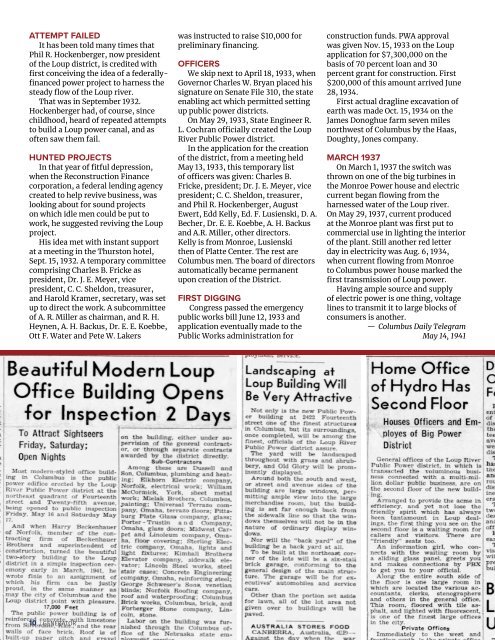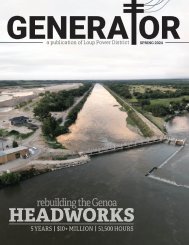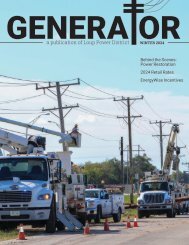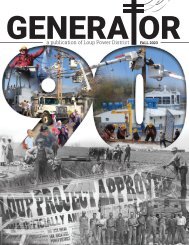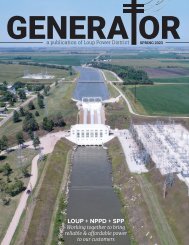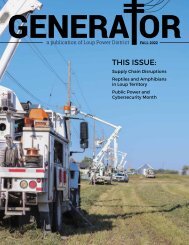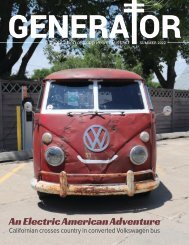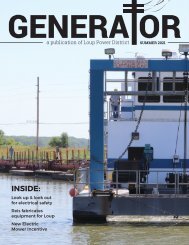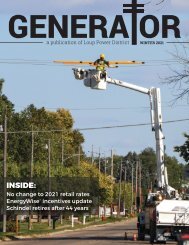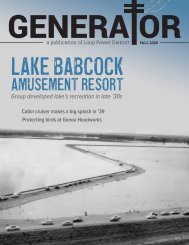Generator — Summer 2023
Learn about the Columbus Public Power Building and a building restoration project in Creston.
Learn about the Columbus Public Power Building and a building restoration project in Creston.
Create successful ePaper yourself
Turn your PDF publications into a flip-book with our unique Google optimized e-Paper software.
ATTEMPT FAILED<br />
It has been told many times that<br />
Phil R. Hockenberger, now president<br />
of the Loup district, is credited with<br />
first conceiving the idea of a federallyfinanced<br />
power project to harness the<br />
steady flow of the Loup river.<br />
That was in September 1932.<br />
Hockenberger had, of course, since<br />
childhood, heard of repeated attempts<br />
to build a Loup power canal, and as<br />
often saw them fail.<br />
HUNTED PROJECTS<br />
In that year of fitful depression,<br />
when the Reconstruction Finance<br />
corporation, a federal lending agency<br />
created to help revive business, was<br />
looking about for sound projects<br />
on which idle men could be put to<br />
work, he suggested reviving the Loup<br />
project.<br />
His idea met with instant support<br />
at a meeting in the Thurston hotel,<br />
Sept. 15, 1932. A temporary committee<br />
comprising Charles B. Fricke as<br />
president, Dr. J. E. Meyer, vice<br />
president, C. C. Sheldon, treasurer,<br />
and Harold Kramer, secretary, was set<br />
up to direct the work. A subcommittee<br />
of A. R. Miller as chairman, and R. H.<br />
Heynen, A. H. Backus, Dr. E. E. Koebbe,<br />
Ott F. Water and Pete W. Lakers<br />
was instructed to raise $10,000 for<br />
preliminary financing.<br />
OFFICERS<br />
We skip next to April 18, 1933, when<br />
Governor Charles W. Bryan placed his<br />
signature on Senate File 310, the state<br />
enabling act which permitted setting<br />
up public power districts.<br />
On May 29, 1933, State Engineer R.<br />
L. Cochran officially created the Loup<br />
River Public Power district.<br />
In the application for the creation<br />
of the district, from a meeting held<br />
May 13, 1933, this temporary list<br />
of officers was given: Charles B.<br />
Fricke, president; Dr. J. E. Meyer, vice<br />
president; C. C. Sheldon, treasurer,<br />
and Phil R. Hockenberger, August<br />
Ewert, Edd Kelly, Ed. F. Lusienski, D. A.<br />
Becher, Dr. E. E. Koebbe, A. H. Backus<br />
and A.R. Miller, other directors.<br />
Kelly is from Monroe, Lusienski<br />
then of Platte Center. The rest are<br />
Columbus men. The board of directors<br />
automatically became permanent<br />
upon creation of the District.<br />
FIRST DIGGING<br />
Congress passed the emergency<br />
public works bill June 12, 1933 and<br />
application eventually made to the<br />
Public Works administration for<br />
construction funds. PWA approval<br />
was given Nov. 15, 1933 on the Loup<br />
application for $7,300,000 on the<br />
basis of 70 percent loan and 30<br />
percent grant for construction. First<br />
$200,000 of this amount arrived June<br />
28, 1934.<br />
First actual dragline excavation of<br />
earth was made Oct. 15, 1934 on the<br />
James Donoghue farm seven miles<br />
northwest of Columbus by the Haas,<br />
Doughty, Jones company.<br />
MARCH 1937<br />
On March 1, 1937 the switch was<br />
thrown on one of the big turbines in<br />
the Monroe Power house and electric<br />
current began flowing from the<br />
harnessed water of the Loup river.<br />
On May 29, 1937, current produced<br />
at the Monroe plant was first put to<br />
commercial use in lighting the interior<br />
of the plant. Still another red letter<br />
day in electricity was Aug. 6, 1934,<br />
when current flowing from Monroe<br />
to Columbus power house marked the<br />
first transmission of Loup power.<br />
Having ample source and supply<br />
of electric power is one thing, voltage<br />
lines to transmit it to large blocks of<br />
consumers is another.<br />
<strong>—</strong> Columbus Daily Telegram<br />
May 14, 1941<br />
10 | GENERATOR


